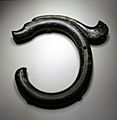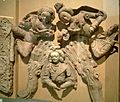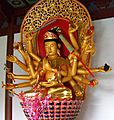China is a country where many people practice different religions, even though the government is officially atheist. The main religions in China are Buddhism, Chinese folk religion, Taoism, and Confucianism. Often, people follow a mix of these beliefs, so the lines between them can be blurry.
Here's a look at how different religions are practiced in China, based on a 2014 study:
Religions in China (2014 survey) Not religious / Chinese folk religion (includes local gods, ancestors, Confucianism, Taoism, Chinese Buddhism) (73.56%) Buddhism (15.87%) Other religions (includes folk salvationism and Taoist groups) (7.60%) Christianity (2.53%) Islam (0.45%)
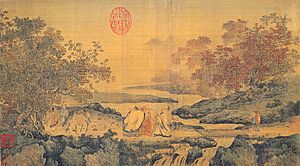
"Three laughs at Tiger Brook", a painting from the Song dynasty (12th century). It shows three men who represent Confucianism, Taoism, and Buddhism laughing together.
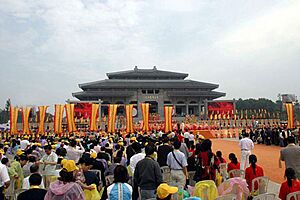
A public worship ceremony at the Great Temple of Yandi Shennong in Suizhou, Hubei.
Buddhism in China
Chinese Buddhism (漢傳佛教) is one of the many types of Buddhism. In China, Buddhism is often mixed with Chinese ways of thinking, local stories, and ideas from other beliefs like Confucianism and Taoism. Most Han Chinese people, who are the largest ethnic group in China, practice this form of Buddhism.
It's not clear exactly when Buddhism first came to China from India. However, the first clear signs of Buddhism in China appeared around 60 CE.
Chinese Folk Religion
Chinese folk religion has been practiced in China for thousands of years. It is a mix of different religious practices. These include Confucianism, honoring ancestors, Buddhism, and Taoism. Many people who follow Chinese folk religion also follow Buddhism, Confucianism, and Taoism. These three beliefs have greatly influenced Chinese folk religion. Sometimes, mythical figures from folk stories have even become part of these other religions, and vice versa.
Chinese folk religion also keeps some older beliefs from ancient times. These include honoring the Sun, Moon, Earth, Heaven, and various stars. It also involves communicating with animals. This religion has been practiced alongside Buddhism, Confucianism, and Taoism by Chinese people around the world for a very long time.
Taoism in China
Taoism (also spelled Daoism) is a philosophy and religion that is at least 2,500 years old. It started in China and is now also widely practiced in Korea.
The word "Dao" (道), or "Tao," refers to a mysterious "Force" that Taoists believe makes everything in the world. Instead of trying to fully understand what the Dao is, Taoists focus on living a simple and balanced life. They believe in living in harmony with nature. This is one of the most important ideas in Taoism. Taoists also believe that fighting or conflict is not good. If you have a problem, they suggest finding a way around it instead of directly confronting it.
Some important figures in Taoism include:
- Lao Zi (老子): His name means "Old Child." Some people believe he wrote the famous book called Dào Dé Jīng.
- Zhuangzi (庄子): He wrote a book filled with stories that explain Taoist ideas.
- Huang Di (黄帝), the Yellow Emperor: Some say he was one of the first Taoists, but it's debated whether he was a real person or a mythical figure.
Images for kids
-
White Horse Temple, a Buddhist Temple in Henan Province.
-
The impressive stupa holding a relic of Shakyamuni Buddha's finger bone, at Famen Temple in Baoji, Shaanxi.
-
Longhua Temple, Shanghai, a place for Buddhist practice.
-
The Grand Buddha at Ling Shan, Wuxi.
-
A jade dragon from the Hongshan culture. Dragons are important symbols in Chinese culture.
-
A squared dǐng (ritual cauldron) with a tāotiè design. These were used in ancient ceremonies.
-
A Tibetan chart for bloodletting based on the Luoshu square.
-
The main hall of the Dai Temple at Mount Tai. This temple is dedicated to the Green Emperor.
-
The eagle-faced Thunder God, who punishes those who go against Heaven's order (1923 drawing).
-
A Han dynasty painting showing the Queen Mother of the West.
-
"Heroic Gesture of the Awakened Being" from Tumxuk, a 6th or 7th-century Buddhist art piece.
-
The Temple of the City God of Sheng County, Zhejiang. These temples are often found in busy areas.
-
The Temple of the Great Buddha in Midong, Urumqi, Xinjiang.
-
An evening market at the Temple of Supreme Brightness, a Taoist temple in Lanzhou, Gansu.
-
A Buddhist temple being repaired in 2015 in Chongwu, Fujian.
-
Statues of the Yellow and Red Deities in Zhengzhou, Henan.
-
A temple dedicated to Mazu, the goddess of the sea, in Shanwei, Guangdong.
-
People worshipping at the Temple of the City God of Suzhou, Jiangsu.
-
The Temple of Hebo ("River Lord"), the god of the Yellow River, in Hequ, Shanxi.
-
Incense Snow Temple, a Buddhist convent in Ouhai, Wenzhou, Zhejiang.
-
A neighborhood folk shrine decorated for a festival in Chongwu, Fujian.
-
Geographic distribution of religions in China.
-
Geographic distributions and major communities of religions in China.
-
Worship at the Great Temple of Lord Zhang Hui, an ancestral shrine in Qinghe, Hebei.
-
A statue of Confucius at a temple in Chongming, Shanghai.
-
A ceremony at a Temple of the Jade Deity in Hebi, Henan.
-
A folk temple on the rooftop of a commercial building in Wenzhou.
-
Xuanyuan Temple in Huangling, Shaanxi, dedicated to the Yellow Emperor.
-
The Temple of the Great Goddess in Fuding, Fujian.
-
The Temple of the God of the South Sea in Guangzhou, Guangdong.
-
The Temple of Guandi, the god of war, in Datong, Shanxi.
-
People gathering at an ancestral shrine in Hong'an, Hubei.
-
The Temple of the Founding Father of the Plum Flower school in Xingtai, Hebei.
-
The Temple of Confucius of Liuzhou, Guangxi. Confucius is worshipped here as "God of Culture."
-
One of the many modern statues of Confucius in China.
-
Prayer flags at a Confucian temple.
-
Stone-carved pillar gates from the Eastern Han dynasty (25-220 AD) in Zhong County, Chongqing.
-
Priests of the Zhengyi order performing a rite at the White Cloud Temple of Shanghai.
-
An altar of the Three Pure Ones, main gods in Taoist beliefs, at a Taoist temple in Yangzhou, Jiangsu.
-
An altar to Shangdi and Doumu, representing the universe's beginning in some Taoist beliefs, in the Chengxu Temple of Zhouzhuang, Jiangsu.
-
Wen Chang, Chinese god of literature, carved in ivory, from the Ming dynasty (around 1550–1644).
-
A wu master from the Xiangxi area.
-
Unwilling-to-Leave Guanyin Temple in Zhoushan, Zhejiang, dedicated to Guanyin.
-
The temple complex with the Ten Directions' Samantabhadra statue at the summit of Mount Emei, Sichuan.
-
The gateway of the Donglin Temple of Shanghai.
-
Larung Gar Buddhist Academy in Sêrtar, Sichuan. It is a very large monastic institution.
-
Mengle Temple, a Theravada temple in Jinghong, Yunnan.
-
Cundī at Lingyin Temple in Hangzhou, Zhejiang.
-
The pan-Chinese Sanxing (Three Star Gods) shown in Bai style at a Benzhu temple in Dali, Yunnan.
-
The Narshi Gompa, a Bonpo monastery in Aba, Sichuan.
-
A Dongba priest writing oracles with a pen in Dongba script, near Lijiang.
-
The Temple of the White Sulde of Genghis Khan in Uxin, Inner Mongolia.
-
A woman worshipping at an aobao in Baotou, Inner Mongolia.
-
Silver Turtle Temple, a major center for Qiang folk religion in Mao, Sichuan.
-
A Protestant church in Kunming, Yunnan.
-
Christ the King Church, a Catholic church in Shenzhen, Guangdong.
-
The Lord's Prayer written in Classical Chinese (1889).
-
Laohua Mosque in Linxia City, Gansu.
-
The gongbei (shrine) of the Sufi master Yu Baba in Linxia City, Gansu.
-
Huxi Mosque and a halal shop in Shanghai.
-
The Synagogue of Harbin, Heilongjiang.
-
The Shanghai Jewish Refugees Museum with its former synagogue.
-
A relief of the Hindu god Narasimha shown at the Quanzhou museum.
-
The Awakened One of Light (Mani) carved from rock at Cao'an, in Jinjiang, Fujian.
-
A Manichaean inscription from 1445 at Cao'an (modern copy).
-
Xianshenlou in Jiexiu, Shanxi, believed to be the only remaining building with Zoroastrian origins in China.
-
An 8th-century clay figure from the Tang dynasty, possibly a Sogdian Zoroastrian priest.
-
A Shinto shrine in Jilin city, Jilin province.
See also
 In Spanish: Religión en la República Popular China para niños
In Spanish: Religión en la República Popular China para niños
 In Spanish: Religión en la República Popular China para niños
In Spanish: Religión en la República Popular China para niños







